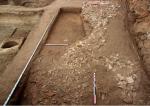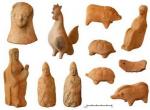Summary (English)
APOLLONIA (Margarit Damyanov – mmdamyanov@gmail.com, Krastina Panaiotova) A layer with material of the Hellenistic period was documented. Graves of the Late Archaic, Classical and Hellenistic periods were situated under the layer. The pile of fragmentary amphorae of the late 4th – first half of the 3rd centuries BC was entirely explored in Trenches E0 – E02. It was a midden. Fragmentary black-gloss kantharoi, unguentaria and other vessels of the first half of the 3rd century BC were found in the midden as well, in addition to earlier objects, some of them originating from destroyed graves: bronze fibulae, finger-rings, a bracelet, an iron xiphos of the 4th century BC and a fragment from tegula with a graffito that reads: ΑΡΠΑΛΟΣ | ΕΠΟΙΗΣΕΝ. Twelve graves (Nos. 15 – 26) were discovered in Trenches E0 – E03. Seven burials belonged to adults laid in burial pits. Five burials belonged to children: three were laid in burial pits, one was buried in the lower part of an amphora and one was covered with a rectangular funerary structure constructed of sherds from two amphorae. The heads of the dead were oriented to the east and only in Grave No. 23 the head of the dead was to the south. Six ceramic vessels and 11 terracotta figurines of 480 – 450 BC were discovered in Grave No. 15 which belonged to a child. Other finds probably originating from destroyed graves from the Classical period were discovered in the excavated area as well, including pottery and a marble funerary stele with inscription that reads: ΘΕΥΓΕΝΗΣ | ΘΕΜΙΣΤΑΓΟ | ΡΕΩ. A Thracian settlement existed on the site during the 11th – 9th century BC. Thracian sherds and a terracotta zoomorphic figurine were found. Fragmentary plaster and sherds of the Late Neolithic period were discovered at some places beneath the Thracian settlement and the Greek burials.
- Margarit Damyanov - Archaeological Institute with Museum
- Krastina Panaiotova - Archaeological Institute with Museum
Director
Team
Research Body
- Archaeological Institute with Museum






![Download [PDF]](/excavation/skins/fasti/images/results/download_sml.png)

